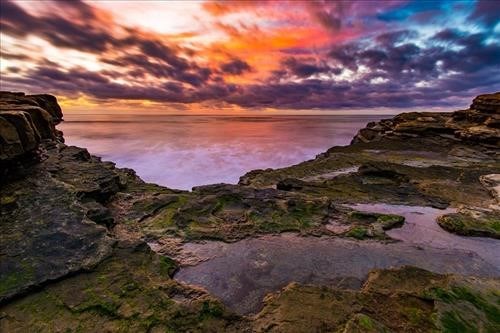Learn about NRCAs
The Natural Resource Condition Assessment (NRCA) Program provides framework, funding, and publishing support to parks to aid in the synthesis and documentation of natural resource conditions. Condition assessment reports are a tool to describe selected park resources, and record a snapshot of their current condition, identify trends, and identify potential or current threats and stressors. Understanding the condition and trend of natural resources is key for parks and NPS planners to appropriately prioritize and allocate stewardship resources.

NPS Photo
Cabrillo National Monument is located on the southern tip of the Point Loma Peninsula, which creates San Diego Bay, extending from the mainland of San Diego, California. The western edge of the Monument has nearly a mile of rocky intertidal area where Point Loma meets the Pacific Ocean. Other features which likely affect the intertidal communities of Cabrillo National Monument include sandstone cliffs and caves, and manmade structures.
Traditional NRCA Report: 2019
In order to better understand the natural resources present in this Monument, a Natural Resource Condition Assessment was written and published in 2019 as a collaborative effort between the NPS, University of California-Santa Barbara, and U.S. Geological Survey. Cabrillo National Monument resource managers requested that the assessment be focused on five key resource topics:
- Vegetation communities |
||
- Rocky intertidal communities |
||
- Terrestrial vertibrates |
||
- Fog dynamics |
||
- Air quality |
Most of the assessed resources at the Monument are either in good condition (vegetation communities, fog dynamics) or warrant moderate concern (rocky intertidal communities, vertebrate communities). One resource – air quality – was rated as a condition of significant concern. Long term monitoring of several biological resources has yielded robust data for determining the status of many of the indicators evaluated in this assessment. Monitoring efforts could, however, be improved with greater spatial replication in repeated survey areas (rocky intertidal species) and more targeted (small mammals) or improved monitoring techniques (bats).
The greatest source of uncertainty in this assessment is in the interpretation of monitoring data. Cabrillo National Monument is well situated to maintain a reasonable semblance of the environment encountered by Cabrillo in 1542. Conservation of that diversity is facilitated by long term monitoring at the Monument and nearby comparable sites, which provides a foundation for the kinds of further research needed to address the knowledge gaps identified in this assessment.
For other reports and natural resource datasets visit the NPS Data Store.
Source: NPS DataStore Collection 7765 (results presented are a subset). To search for additional information, visit the NPS DataStore.
Last updated: February 25, 2022
